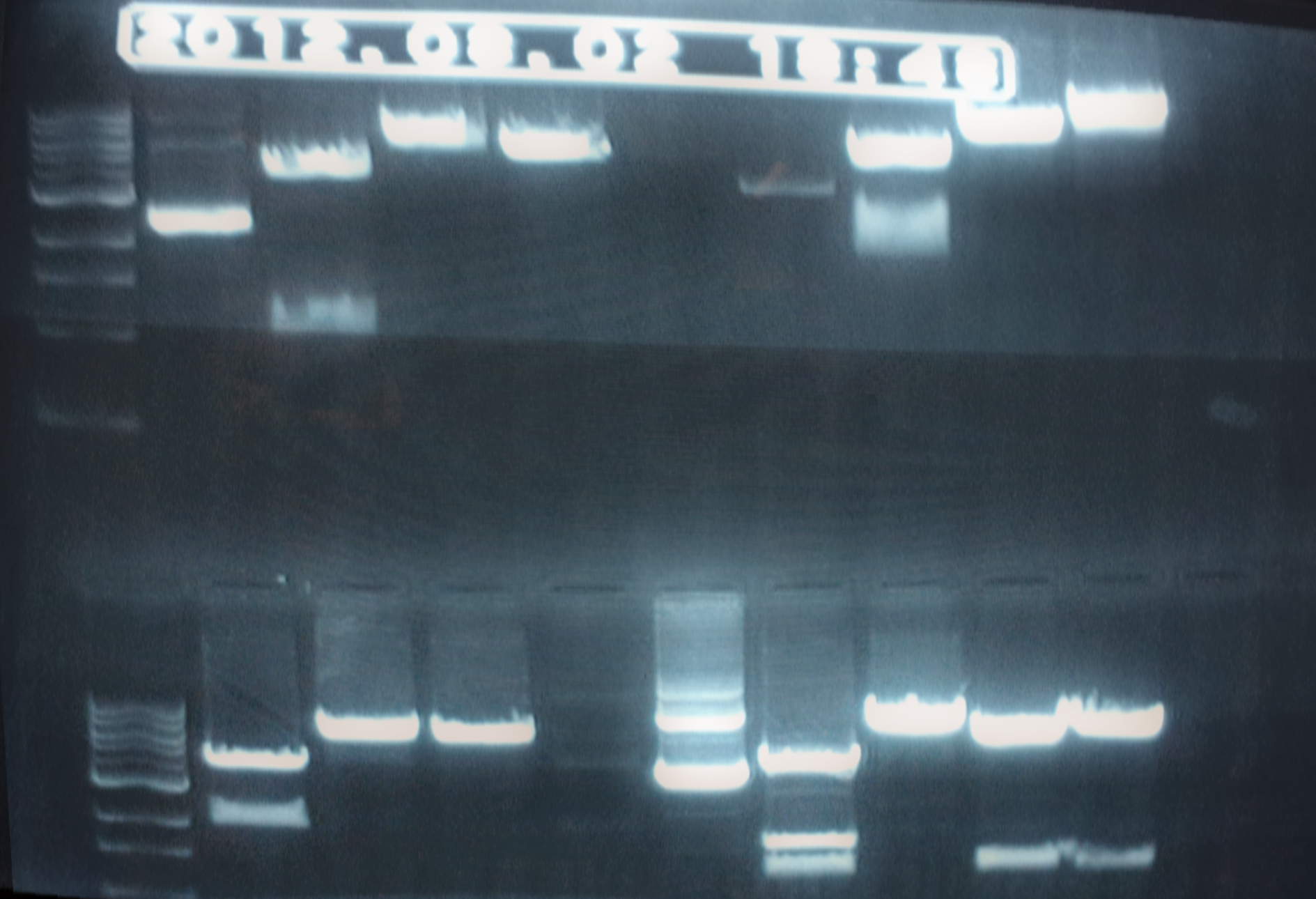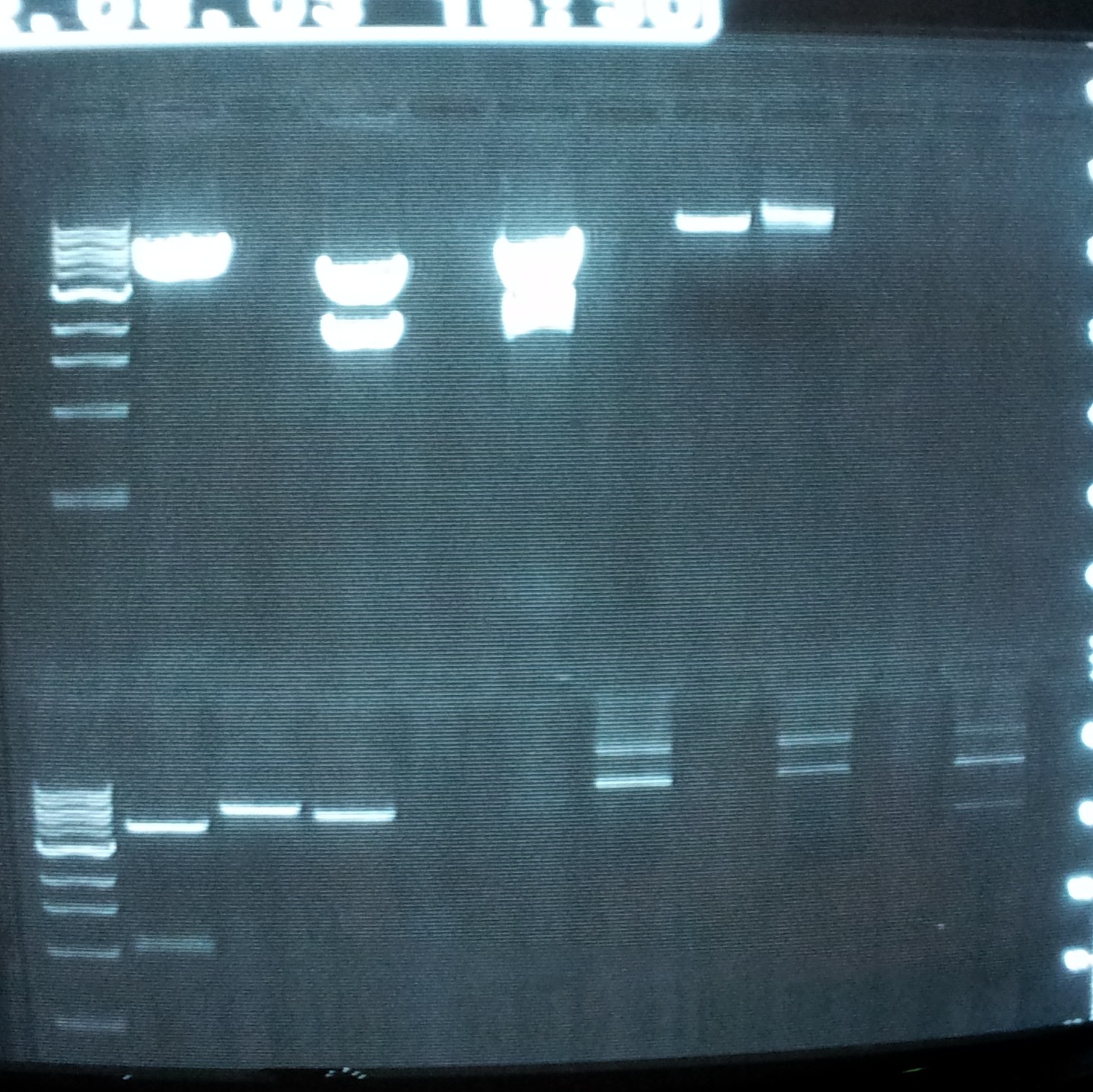Contents |
Digestion of pMP and pGL4.30 for ligation
Protocol: Restriction site digestion
- Look for the best pair of restriction sites, ideally with similar digestion temperatures and times.
- [http://tools.neb.com/NEBcutter2/ NEBcutter] for finding cutting enzymes.
- [http://www.neb.com/nebecomm/DoubleDigestCalculator.asp Double Digest Finder] for the parameters.
- Calculate the amounts required of:
- DNA
- Buffer (usually from 10x to 1x)
- BSA, if needed (usually from 100x to 1x)
- Enzymes (depends on the amount of DNA)
- Water
- Get the recommended buffer (and BSA if needed) from the freezer and let defreeze.
- Mix all the ingredients, except DNA, in a tube.
- Note: Enzymes should stay no longer than a couple of minutes out of the freezer. Don't touch the bottom of the tubes! Don't vortex!
- Distribute the mix in as many tubes as DNA samples and add the DNA.
- Keep in the Thermomixer at the recommended temperature.
Sowmya's recommended amounts (50 µl total solution):
- 5 µl of 10x buffer
- 0.5 µl of 100x BSA
- 1 µl of each enzyme
- 5 µl of DNA
- 37.5 (up to 50 µl) of water.
Protocol based on what was done on July the 4th.
Prepared pMP2, pGL2 and pGL3 for ligation.
The restriction enzyme digest mixtures were as follows:
- pMP2 control for plasmid
- DNA 2µL
- HindIII 1µL
- XbaI 1µL
- N4 buffer 10x 5µL
- BSA 100x 0.5µL
- Water 40.5 µL
- pMP2 control for NotI
- DNA 2µL
- NotI 1µL
- N4 buffer 10x 5µL
- BSA 100x 0.5µL
- Water 41.5 µL
- pMP2 control for SpeI
- DNA 2µL
- SpeI 1µL
- N4 buffer 10x 5µL
- BSA 100x 0.5µL
- Water 41.5 µL
- pMP2 for ligation
- DNA 19µL
- SpeI 1µL
- NotI 1µL
- N2 buffer 10x 5µL
- BSA 100x 0.5µL
- Water 23.5 µL
- pGL2 for ligation
- DNA 12µL
- HindIII 1µL
- MfeI 1µL
- N4 buffer 10x 5µL
- BSA 100x 0.5µL
- Water 31 µL
- pGL3 for ligation
- DNA 16µL
- HindIII 1µL
- FseI 1µL
- N4 buffer 10x 5µL
- BSA 100x 0.5µL
- Water 26.5 µL
All left for 1:30 hours at 37ºC, shaking (600 rpm).
After that we ran the digestion products in a gel (1% agarose, 50 µl of digestion product + 10 µl of loading dye).
Protocol: Gel Electrophoresis
Agarose concentration depends on the size of the DNA to be run. We will mostly use 1%.
VOL is the desired volume of gel in ml:
CH Lab
- Add 0.01*VOL g of agarose to a clean glass bottle.
- Pour VOL/50 ml of 50xTAE in a graduated cylinder. Fill up to VOL ml with di water.
- Add the resulting VOL ml of 1xTAE to the glass bottle with agarose.
- Microwave, at 7, the bottle (loose cap!) until it boils.
- Carefully remove bottle (can be super heated!) and check for the total absence of particles. Microwave again if needed.
- Prepare a gel box, with comb, and fill it up with the agarose solution (maybe not the whole solution is needed).
- Add 0.05 µl per ml of gel in the box of Red Gel (it's in the iGEM drawer) and stirr until disolved.
- Wait until cold and solidified.
- Carefully remove comb.
- Place the box in the electrophoresis chamber.
- Fill up the electrophresis chamber with 1x TAE buffer.
- Add blue dye to the DNA samples (6x loading buffer, that is 10 µl in 50 µl of DNA solution).
- Inject 30 µl of ladder marker in the first well (that's 1 µg of DNA).
- Inject 60 µl of each DNA solution in the other wells.
- Set voltage to 70-90 V and run for 30-40 min, or until the dye reaches the last 25% of the gel length (DNA travels from - to +).
- Place the gel under the camera, cover, turn UV on and take photos!
Preparing the ladder:
- get 1kb ladder DNA from the freezer (500 µg/ml).
- for 30 charges, 30 µl per charge, we need 900 µl:
- 60 µl of 1kb ladder DNA
- 150 µl of dye (6x loading buffer)
- 690 µl of water
BM Lab
In this lab the gels are slightly different. The total volumes for the small, the medium and the large gel are respectively 60ml, 80ml and 90ml. As we use 0.5x TAE buffer instead of 1x, we can use higher voltages (170V seems to work fine). The gel should run 20-40 minutes, not more. As the gel is thinner, load less DNA (up to ~10ul).
- Top Row:
- Ladder
- Empty
- pMP2 cut with Not+SpeI
- Empty
- pGL2 cut with HindIII+MfeI
- Empty
- pGL3 cut with HindIII+FseI
- Empty
- Control of HindIII with pGL3
- Control of FseI with pGL3
- Bottom Row:
- Ladder
- Control with HindIII and XbaI for pMP2
- Control of NotI with pMP2
- Control of SpeI with pMP2
- Empty
- Empty
- eGFP PCR product
- Empty
- TNFR PCR product
- Empty
- SEAP PCR product
The gel fragments corresponding to the linearized backbones in wells 3, 5 and 7 on the top comb were cut out with a razor blade. The PCR products in wells 8, 10 and 12 on the bottom comb were also cut out.
The gel fragments were run through a QIAGEN gel purification kit.
 "
"

